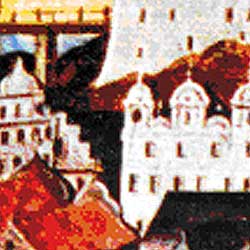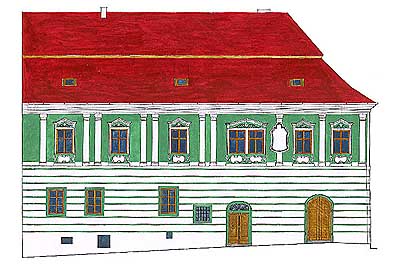Panská No. 22
Description of the Building:
A one-storey expansive house on the corner with a curb roof and
elements of a Classical reconstruction from the end of the 18th
century. The main front, facing Panská street, is interrupted. The
entrance hall is vaulted with barrel vaults. On the elevated ground
floor on the left is a room with barrel vaults with sectors and a
corner room with cross vaults. On the upper floor are flat
ceilings.
Architectural and Historical Development:
The building probably originated on two medieval land parcels,
integrated even in the Gothic period. The house was rebuilt in the
Rennaissance period and in the early-Baroque, as we can estimate in
both extensive rooms with vaults on the elevated ground floor. A
significant reconstruction was carried out at the end of the 18th
century - the layout on the first floor, vaulting of the entrance
hall, the roof and the front were newly designed. At the end of the
19th century a new staircase to the upper floor was set and a new
vault of the front cellar was made in the mid-20th century.
Development of facade:
There had probably been two gables arranged in the form of steps in
the facade from the late Middele Ages period. The icongraphy of
that period (18th century) shows the corner gable. Secondary used
stone-cutting window elements from the Middle Ages period appeared
in the building. The original plaster design was markedly changed
during the Baroque-Classicism period, when the building was
radically rebuilt. The front at the 1st floor level was articulated
with a pilaster, window holes on the 1st floor were framed with
band shams with triangle-shape cranked pediments and window ledge
filling.
The band rustic-work articulated the ground-floor. Discovered coloured articulations: green-and-white-coloured, ochre-and-white-coloured. The window ledge filling was decorated with the red-coloured illusion marble. The facade r estoration was done in 1996. The Classicism scheme inspired the coloured articulation and the silicate technology was used.
 Significant
Architectural Features:
Significant
Architectural Features:
- a pointed portal of the door which leads to the yard
- a saddle portal in the central aisle on the ground floor
- a saddle portal on the elevated ground floor
- Gothic window jambs of the entrance hall
- the depth of the back cellar with a remarkably long staircase
- a glazing bar of a moulded three-piece medieval window secondly used as
- a side post between windows on the first floor
- the upper floor - the corner room - a late-Gothic mural of The Passion of St Šebestián (?), a Rosenberg coat-of-arms and a coat-of-arms of the Lords of Gutstein (?), the ornamental Rococo decoration of the room
- the corner room on the elevated ground floor - a late-Gothic vegetative framing of vaulting
- ridge elements of Baroque-Clasical facade articulation with the
Mariánský mural
History of the House Residents: In
the years 1459 -1466 Jan Blahut was the owner of the house,
followed by a certain Petril in 1484 and Glacl in the years 1500
-1504. From 1510 the house belonged to a stone-mason and a
Rosenberg architect Hans Götzinger. In 1526 Götzinger sold it to
Tomáš Turek - a rich burgess, merchant and councillor, who owned it
to 1551. Turek´s family disorder, caused by a tendency of his wife
towards theft, was solved in the town council and in front of the
Rosenberg lordship. In 1551 the house was bought by a Rosenberg
official Alexandr Škola of Grünperk, a district administrator at
Rožmberk, who owned it until 1566. In 1557 Karel of Žerotín with
his suite were lodged in the house. The following owner was from
1566 a tailor Kašpar Teufel-Čert, son of Ondřej Čert from the house
No. 1 in the square. Discontented, constantly arguing with his
relatives, Kašpar had to sell the house because of debts to Kolman
Egrer in 1571. The house was bought from Egrer in 1573 by Jan Višně
of Větřní na Pasovarech and Jan´s son Adam Višně of Větřní na
Pasovarech sold it to Linhart Hauzenperger in 1580. After Linhart´s
death his son Jakub became the owner of the house in 1585. He
exchanged it in 1608 for the house of Zikmund Höricer at Soukenická
No. 44. After Horicer the house was kept by a closely unknown
Preininger, whose heirs sold it to Jan Payerhuber in 1634. In 1638
the house was bought by a draper Jiří Miess, who died in about
1648. The following owner was Albín Tuck, who was confirmed there
by the Roll of Assessment. His son Jan, who was also a draper,
lived in the house to 1742. After several different owners Antonín
Svoboda, who was a brewer at the town brewery, came in from 1781 -
1800, and later on Jan Kindl, who was succeeded by Antonín
Prokop.
In
the years 1459 -1466 Jan Blahut was the owner of the house,
followed by a certain Petril in 1484 and Glacl in the years 1500
-1504. From 1510 the house belonged to a stone-mason and a
Rosenberg architect Hans Götzinger. In 1526 Götzinger sold it to
Tomáš Turek - a rich burgess, merchant and councillor, who owned it
to 1551. Turek´s family disorder, caused by a tendency of his wife
towards theft, was solved in the town council and in front of the
Rosenberg lordship. In 1551 the house was bought by a Rosenberg
official Alexandr Škola of Grünperk, a district administrator at
Rožmberk, who owned it until 1566. In 1557 Karel of Žerotín with
his suite were lodged in the house. The following owner was from
1566 a tailor Kašpar Teufel-Čert, son of Ondřej Čert from the house
No. 1 in the square. Discontented, constantly arguing with his
relatives, Kašpar had to sell the house because of debts to Kolman
Egrer in 1571. The house was bought from Egrer in 1573 by Jan Višně
of Větřní na Pasovarech and Jan´s son Adam Višně of Větřní na
Pasovarech sold it to Linhart Hauzenperger in 1580. After Linhart´s
death his son Jakub became the owner of the house in 1585. He
exchanged it in 1608 for the house of Zikmund Höricer at Soukenická
No. 44. After Horicer the house was kept by a closely unknown
Preininger, whose heirs sold it to Jan Payerhuber in 1634. In 1638
the house was bought by a draper Jiří Miess, who died in about
1648. The following owner was Albín Tuck, who was confirmed there
by the Roll of Assessment. His son Jan, who was also a draper,
lived in the house to 1742. After several different owners Antonín
Svoboda, who was a brewer at the town brewery, came in from 1781 -
1800, and later on Jan Kindl, who was succeeded by Antonín
Prokop.
Present Use:
Sparkasse Muhlviertel West Bank



